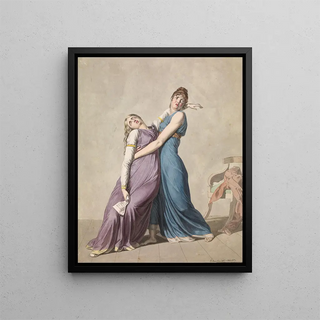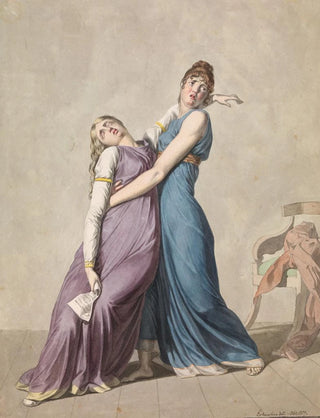Art print | A woman supports another woman who has fainted while reading a letter - Christoffer Wilhelm Eckersberg


View from behind

Frame (optional)
In the world of art, some works manage to capture moments of pure emotion, transcending time and space. "A woman supports another woman who has fainted while reading a letter" by Christoffer Wilhelm Eckersberg is one of these striking pieces. This canvas, imbued with delicacy and depth, immerses us in a scene charged with emotional tension, where the intimacy of the characters unfolds with rare intensity. The work evokes universal themes such as love, compassion, and vulnerability, inviting the viewer to reflect on human relationships and the trials they can entail.
Style and uniqueness of the artwork
Eckersberg, master of Danish realism, stands out for his ability to blend impeccable technique with profound sensitivity. In this piece, light plays a fundamental role, illuminating the faces of the two women and highlighting the details of their expressions. The contrast between the supported woman, whose face shows anxiety and surprise, and the one helping her, filled with gentleness and determination, creates a poignant dynamic. The composition is carefully orchestrated, with each element in its place to enhance the visual narrative. The drapery of the clothing, delicate gestures, and the posture of the characters harmonize to bring to life a scene that is both realistic and emotionally charged. This attention to detail, combined with a subtle color palette, gives the artwork an almost palpable atmosphere.
The artist and his influence
Christoffer Wilhelm Eckersberg, often regarded as the father of Danish realism, made his mark on his era through an innovative approach to painting. Trained at the Royal Danish Academy of Fine Arts in Copenhagen, he was also influenced by his travels in Italy, where he discovered the masters of the past. His work is set within a historical context where art moved away from classical ideals to embrace a more authentic representation of everyday life. Eckersberg was able to capture the psychology of his characters, endowing them with a humanity that still resonates today.

Matte finish

View from behind

Frame (optional)
In the world of art, some works manage to capture moments of pure emotion, transcending time and space. "A woman supports another woman who has fainted while reading a letter" by Christoffer Wilhelm Eckersberg is one of these striking pieces. This canvas, imbued with delicacy and depth, immerses us in a scene charged with emotional tension, where the intimacy of the characters unfolds with rare intensity. The work evokes universal themes such as love, compassion, and vulnerability, inviting the viewer to reflect on human relationships and the trials they can entail.
Style and uniqueness of the artwork
Eckersberg, master of Danish realism, stands out for his ability to blend impeccable technique with profound sensitivity. In this piece, light plays a fundamental role, illuminating the faces of the two women and highlighting the details of their expressions. The contrast between the supported woman, whose face shows anxiety and surprise, and the one helping her, filled with gentleness and determination, creates a poignant dynamic. The composition is carefully orchestrated, with each element in its place to enhance the visual narrative. The drapery of the clothing, delicate gestures, and the posture of the characters harmonize to bring to life a scene that is both realistic and emotionally charged. This attention to detail, combined with a subtle color palette, gives the artwork an almost palpable atmosphere.
The artist and his influence
Christoffer Wilhelm Eckersberg, often regarded as the father of Danish realism, made his mark on his era through an innovative approach to painting. Trained at the Royal Danish Academy of Fine Arts in Copenhagen, he was also influenced by his travels in Italy, where he discovered the masters of the past. His work is set within a historical context where art moved away from classical ideals to embrace a more authentic representation of everyday life. Eckersberg was able to capture the psychology of his characters, endowing them with a humanity that still resonates today.






